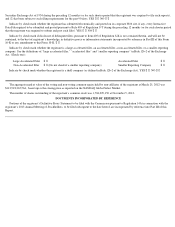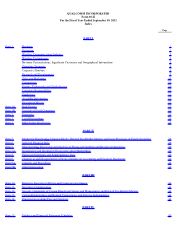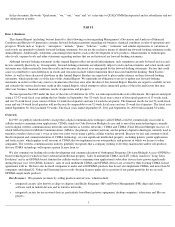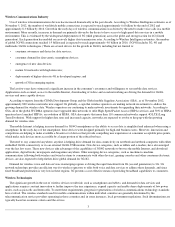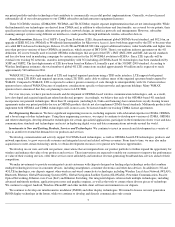Qualcomm 2012 Annual Report Download - page 13
Download and view the complete annual report
Please find page 13 of the 2012 Qualcomm annual report below. You can navigate through the pages in the report by either clicking on the pages listed below, or by using the keyword search tool below to find specific information within the annual report.
CDMA2000 1X and 1xEV-DO, as well as the EV-DO Revision A/B evolutions of CDMA 2000 technology. Leveraging our expertise in
CDMA, we also developed and offer integrated circuits supporting the WCDMA version of 3G for manufacturers of wireless devices. More than
80 device manufacturers have selected our WCDMA products that support GSM/GPRS, WCDMA, HSDPA (High-Speed Downlink Packet
Access), HSUPA (High-Speed Uplink Packet Access) and HSPA+ for their devices. QCT also sells multimode products for the LTE standard,
which offer seamless backward compatibility to existing 3G technologies.
Our integrated circuit products span a broad range of products, from entry-level products for emerging regions, such as our Qualcomm
Reference Design (QRD) products, up to very high-end devices. Our chipsets integrate unique combinations of features, such as multi-
megapixel
cameras, videotelephony, streaming multimedia, audio, 3D graphics, advanced position-location capabilities through integrated gpsOne
technology and peripheral connectivity, to enable a wide range of devices.
Our IZat location technologies are featured in more than 50 operator networks around the globe. By combining location data from satellite
systems (GPS and GLONASS), cellular and Wi-Fi networks, sensors and cloud-based assistance servers, our location products deliver accurate,
always-on location awareness that enhances the mobile experience. We offer both integrated and stand alone location products for use in mobile
phones, tablets, notebooks, cameras and other consumer devices.
The Snapdragon family of processors is a highly integrated, mobile optimized system on a chip incorporating our advanced technologies,
including high performance central processing units (CPU), graphics processing units (GPU) and modems, multimedia subsystems, including
audio, video and camera capabilities, and highly accurate GPS engines. Our CPU cores are custom designed to deliver high levels of compute
performance at ultra-low power, allowing manufacturers to design slim and powerful devices that last longer between charges. Our GPUs are
also custom designed to deliver graphics performance for gaming and user interfaces. The Snapdragon family also incorporates our modem
technology for advanced mobile broadband and a feature-rich multimedia subsystem that delivers audio and high-definition video capabilities.
Our modems are built to work with increasingly complex networks. They support the latest communication technologies and adapt to
network conditions and user needs in real time to enable delivery of faster, smoother data and voice connections. Our 3G/4G modem roadmap
delivers the latest network technologies across multiple product tiers and devices. This roadmap is the result of our years of research into
emerging network standards and the development of chipsets that take advantage of these new standards, while maintaining backward
compatibility with existing standards.
Through our acquisition in May 2011 of Atheros Communications, Inc., which was renamed Qualcomm Atheros, Inc., QCT also offers an
expanded portfolio of connectivity technologies, which complements our mobile business and extends our capability into networking and
infrastructure products. QCT is a leading provider of wireless and wired connectivity products, including networking products for consumers,
carriers and enterprise equipment, mobile handsets and mobile and fixed computing and consumer electronics products. Our wireless products
consist of integrated circuits and system software for WLAN, Bluetooth and frequency modulation (FM) as well as technologies that enable
location data and services, including GPS and GLONASS. Our wireless technologies are provided in the form of WLAN, Bluetooth and FM
integrated products, WLAN and Bluetooth combination and standalone products. Our wired connectivity products consist of integrated circuits
and software for Ethernet, powerline and passive optical networks. Our wired portfolio enables delivery of richer, comprehensive multi-
connectivity product platforms to our networking, computing and consumer electronics customer base. Our passive optical network technologies
provide our customers with solutions for their fiber optics, broadband and access businesses. We employ our WLAN, powerline and Ethernet
technologies in combination to deliver hybrid platforms known as Hy-Fi products.
The market in which our QCT segment operates is intensely competitive. QCT competes worldwide with a number of United States and
international designers and manufacturers of semiconductors. As a result of global expansion by foreign and domestic competitors, technological
changes and the potential for further industry consolidation, we anticipate the market to remain very competitive. We believe that the principal
competitive factors for our products may include performance, level of integration, quality, compliance with industry standards, price, time-to-
market, system cost, design and engineering capabilities, new product innovation and customer support. We also compete in both single- and
dual-mode environments against alternative communications technologies including but not limited to, GSM/GPRS/EDGE, TDMA, TD-
SCDMA and WiMAX.
QCT’s current competitors include, but are not limited to, major companies such as Broadcom, CSR plc, Freescale, HiSilicon Technologies,
Intel, Lantiq, Marvell Technology, MediaTek, nVidia, Renesas Electronics, Spreadtrum Communications, ST-Ericsson (a joint venture between
Ericsson Mobile Platforms and ST-NXP Wireless), Texas Instruments and VIA Telecom, as well as major communications equipment
companies such as Matsushita, Motorola Mobility and Samsung, who design at least some of their own integrated circuits and software for
certain products. QCT also faces competition from some early-stage companies. Our competitors devote significant amounts of their financial,
technical and other resources to develop and market competitive products and, in some cases, to develop and adopt competitive digital cellular
technologies, and those efforts may materially and adversely affect QCT. Moreover, competitors may offer more attractive product pricing or
financing terms or have a more established presence in certain device markets or emerging geographic regions than we do as a means of gaining
access to the market or customers.
7


